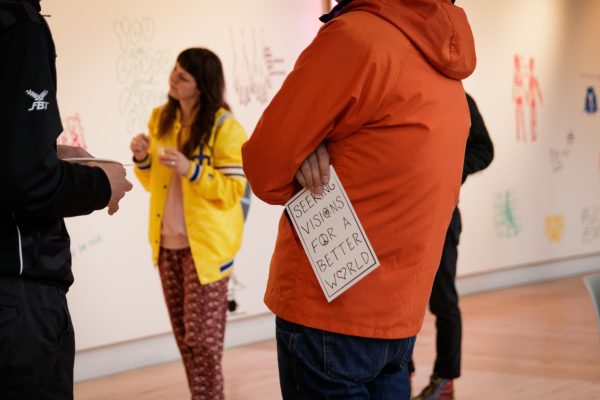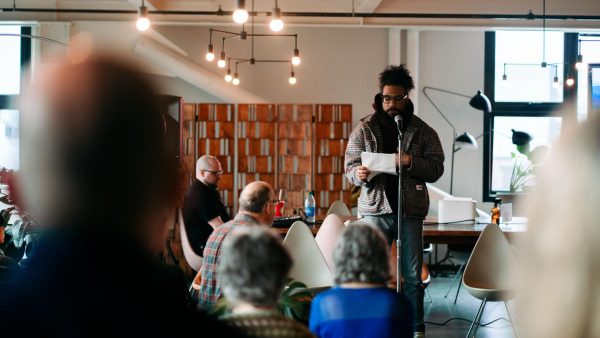Local Artist Interprets Migration as Humanitarian Crisis
With every piece of her art, from abstract paintings to an ornamental rug made of flour, Mary Ann Peters depicts her interpretation of scenes of migration in countries like Lebanon and Syria.
Town Hall Seattle hosted local artists Peters and Gary Faigin on April 5 to discuss Peters’ recent works surrounding the refugee crisis and migration, as part of Town Hall’s ‘Inside Out’ event series. Peters was the Artist in Residence of Seattle University in 2012 and Faigin is currently the artistic director at the Gage Academy of Art in Seattle.
Peters said that she saw it as her duty to educate herself to change the common and erroneous ideas of what that area of the world looks like.
“I felt that because my heritage was Lebanese and because my family was of Arab descent and because there were so many incidents of people of Arab descent being maligned that it made almost an ethical dilemma for me to not look at this topic and make this work,” she said.
Many of her works are what Peters refers to as an “after image.” She is responding to history and removes the nostalgia surrounding a particular event or heritage, instead replacing it with education. Some work that mirrors this sentiment is her recent series “this trembling turf,” which is made of white ink on black scratchboard and depicted the search for things that are buried.
While studying at the Arab Image Foundation, Peters learned about the possible existence of a mass grave under a golf course in Beirut, Lebanon, which would be aligned with an incident that happened in a Palestinian neighborhood adjacent to the course. The mass grave has never been formally confirmed but it inspired Peters to read about forensic anthropology and its tools.
“It for me is just that we walk on histories, some of them are painful and some of them are just sublimated sensitivities or sentimentalities,” she said. “But they’re important, they’re the record of our existence.”
In a series of works entitled “impossible monuments,” Peters depicts smaller events of tragedy that feed larger ones. One such piece is a massive installation called “impossible monument (nothing but the memory)” in which Peters tackles the people who have profited off demise and tragedy of those trying to migrate across the Mediterranean.
Some people sell faulty floatation devices to those trying to flee, some of which are filled with newspapers instead of air. With this in mind, Peters’ installation consisted of two walls covered in wound up newspapers, with pieces of backpacks or bags found interspersed among the newspapers.
Throughout the evening, Peters stressed that instead of referring to the issue as a migration crisis, we should acknowledge there is actually a worldwide humanitarian crisis occurring. She said that there is a serious question left in the fray of whether we will be willing to accommodate people in need, in this case those with refugee status.
Another piece, “impossible monuments: flotsam,” is an interpretation of a story Peters heard from a nurse from doctors without borders. The nurse told Peters about Yemeni fishermen he had spoken with who found belongings and remains of those trying to cross the Mediterranean in their fishnets.
With this, Peters created a piece consisting of a fishing net filled with items that would be found with a refugee. Peters said that the most important thing taken is typically a phone and the most needed item is Wi-Fi to communicate. Peters was particularly surprised to learn that many people carry lemons with them, as sucking on lemons can help cure the sea sickness that comes with travelling on questionable boats.
Event attendees Barbara Robertson and Janet Berkow know Peters and her work and were interested in hearing more about her experiences.
“I know her and I’m a visual artist myself. So, I knew she was speaking here and I thought she’s always good,” Robertson said.
Berkow was most impressed by Peters’s immense range of materials used in her work, as she has pieces made from almost any medium imaginable, including paint, flour and a sail.
“And it was always in response to a particular train of thought, so she doesn’t start with materials, she doesn’t start with art making,” Berkow said, “She starts with an experience and digesting it and making it personal enough and then finding out what the right way is to express it.”
Peters said that her art pieces are her own way of changing the world, and its perceptions of migration, a little bit at a time.
“We are all in some state of concern about the world and you can just choose your pocket that you want to give some sort of credence to,” she said.
Sofía may be reached at
[email protected]







![Jordan Ward [REVIEW]](https://seattlespectator.com/wp-content/uploads/2024/04/ward_1-600x400.jpg)

![COWBOY CARTER [REVIEW]](https://seattlespectator.com/wp-content/uploads/2024/04/Screenshot-2024-04-10-at-7.37.52 PM-600x349.png)